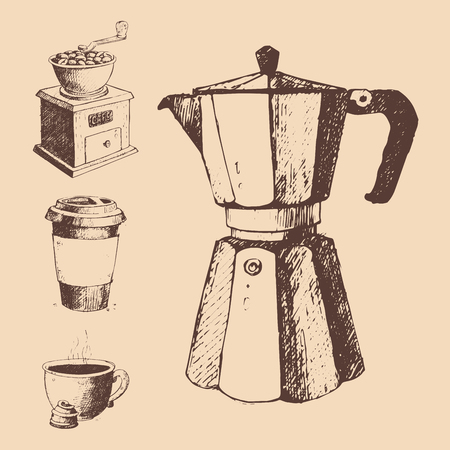1. Understanding the Basics of Coffee Grinders
If youre brewing coffee at home in the U.S., whether its a morning drip, a weekend French press, or a bold shot of espresso, one key piece of gear can make or break your cup: the coffee grinder. Lets break down what grinders do, why they matter, and how they affect your favorite brew.
What Does a Coffee Grinder Do?
In simple terms, a coffee grinder takes whole roasted beans and breaks them down into smaller particles so you can brew them. The consistency and size of these grounds are crucial because they determine how water extracts flavor from the beans. Different brewing methods need different grind sizes to taste their best.
Why the Type of Grinder Matters
There are two main types of grinders youll find in American kitchens: blade grinders and burr grinders. They both grind coffee, but the way they do it—and the results they deliver—are very different.
Blade Grinders vs. Burr Grinders at a Glance
| Feature | Blade Grinder | Burr Grinder |
|---|---|---|
| Grinding Method | Uses spinning blades to chop beans | Uses two burrs to crush beans evenly |
| Grind Consistency | Uneven (can lead to over- or under-extraction) | Uniform (better flavor control) |
| Price Range (U.S.) | $15–$40 (budget-friendly) | $60–$300+ (higher investment) |
| Best For | Casual drinkers, basic drip machines | Coffee enthusiasts, espresso lovers, pour-over fans |
| Noise Level | Louder due to fast spinning blades | Quieter (especially manual burr models) |
| Durability | Shorter lifespan; plastic parts wear quickly | Built to last; often made with metal components |
The Impact on Your Daily Brew
If youre using a French press or cold brew setup, you’ll want a coarse grind. Espresso? That needs something super fine. A blade grinder might give you a mix of powder and chunks—not ideal. Burr grinders let you dial in exactly what you need for each method, making your morning cup smoother and more flavorful.
Common U.S. Brewing Methods & Recommended Grind Sizes:
| Brewing Method | Recommended Grind Size |
|---|---|
| Drip Coffee Maker (Mr. Coffee, Keurig with reusable pod) | Medium grind |
| French Press (popular weekend choice) | Coarse grind |
| Pourover (like Chemex or Hario V60) | Medium-fine grind |
| Espresso Machine (Breville, De’Longhi) | Fine grind |
| AeroPress (on-the-go favorite) | Fine to medium-fine grind depending on brew time |
| Cold Brew (Mason jar method or Toddy system) | Extra-coarse grind |
The right grinder helps unlock your coffees full potential. Whether youre just starting out or leveling up your home barista game, understanding how grinders work is the first step toward better coffee every day.
2. Blade Grinders: The Pros and Cons
Blade grinders are often the first stop for many coffee lovers in the U.S. looking to grind their own beans at home. Theyre compact, budget-friendly, and easy to use—just pop in your beans, press a button, and youre grinding. But while theyre accessible, they come with a few trade-offs that can affect your morning brew.
How Blade Grinders Work
Blade grinders use a spinning blade—kind of like a blender—to chop up coffee beans. The longer you hold down the button, the finer the grind becomes. It’s a simple mechanism that gets the job done quickly, but not always evenly.
The Upside: Affordability and Convenience
If youre just getting into brewing coffee at home or youre on a tight budget, a blade grinder might seem like a no-brainer. Heres why:
| Pros | Details |
|---|---|
| Low Cost | Most blade grinders are priced under $30, making them an affordable entry point. |
| Easy to Use | Just push a button—no complicated settings or adjustments needed. |
| Compact Size | Small enough to fit in any kitchen cabinet or countertop space. |
The Downside: Inconsistency and Heat
The biggest issue with blade grinders is inconsistency. Because the blades randomly chop rather than grind uniformly, you often end up with a mix of fine powder and large chunks. This unevenness can seriously impact the flavor of your coffee, especially if youre using methods like pour-over or French press that require specific grind sizes.
Common Pitfalls:
- Inconsistent Grind Size: Leads to uneven extraction, which can make your coffee taste bitter or sour.
- Heat Buildup: The fast-spinning blades can heat up during grinding, potentially affecting the flavor by slightly “cooking” the beans.
- Lack of Control: Theres no setting for grind size—you just have to guess based on how long you hold down the button.
Is a Blade Grinder Right for You?
If youre mostly brewing drip coffee or using an automatic coffee maker and want something quick and inexpensive, a blade grinder might do the trick. Just be aware that it won’t deliver barista-level results. For those who care about precision and flavor consistency, its worth exploring other options—which we’ll cover in the next section.

3. Burr Grinders: Why They’re Preferred by Coffee Enthusiasts
If youve ever wondered why serious coffee lovers in the U.S. tend to steer clear of blade grinders, its because burr grinders offer a totally different level of control and consistency. Whether youre brewing a strong espresso shot or a smooth pour-over, burr grinders help you get the most flavor out of your beans.
What Makes Burr Grinders Different?
Unlike blade grinders that chop beans unevenly, burr grinders crush coffee beans between two abrasive surfaces (called burrs). This method creates uniform grind sizes, which leads to better flavor extraction during brewing. Uniformity is key when it comes to making great coffee—especially if youre using methods like espresso or French press where grind size really matters.
Consistency = Better Coffee
One of the biggest reasons people choose burr grinders is for consistency. With even grind sizes, your coffee brews more evenly. This means fewer sour or bitter notes and more balanced flavors in every cup. Its why many specialty cafés and home baristas rely on burr grinders daily.
More Control Over Your Grind
Burr grinders let you adjust the grind size with precision. Want a fine grind for espresso? No problem. Need a coarse grind for cold brew? Easy. This kind of control helps you dial in your brew exactly how you like it, which is something blade grinders just cant do.
Blade vs Burr Grinder Comparison
| Feature | Blade Grinder | Burr Grinder |
|---|---|---|
| Grind Consistency | Poor – uneven particles | Excellent – uniform size |
| Flavor Extraction | Inconsistent results | Balanced and full-bodied |
| Grind Size Control | Limited | Precise adjustments possible |
| Heat Buildup (affects taste) | High due to fast spinning blades | Low – slower grinding reduces heat |
| Price Range | $15–$30 (budget-friendly) | $60–$300+ (higher investment) |
| Lifespan & Durability | Shorter lifespan, less durable parts | Built to last with quality components |
A Favorite Among U.S. Coffee Lovers
Burr grinders have become a staple for American home brewers who want café-quality coffee at home. They’re especially popular among folks who enjoy experimenting with different brewing methods or who subscribe to fresh whole bean deliveries from local roasters.
Tip:
If youre just getting into specialty coffee, starting with a reliable entry-level burr grinder can make a huge difference in your daily cup—without breaking the bank.
4. Flavor and Brew Quality: What’s the Real Difference?
When it comes to brewing that perfect cup of coffee, grind consistency plays a huge role—more than most people realize. Whether you’re using a French press, drip machine, or espresso maker, the way your coffee is ground affects everything from flavor to mouthfeel. Let’s break down how blade and burr grinders stack up when it comes to taste.
Grind Consistency: Why It Matters
Grind consistency means all your coffee grounds are roughly the same size. This matters because uneven grounds extract at different rates—some may be over-extracted (bitter), while others are under-extracted (sour). The result? A cup that tastes off or muddled. Consistent grinds lead to balanced flavor, better aroma, and more control over your brew.
Blade Grinders: Inconsistent Results
Blade grinders chop beans with spinning blades, kind of like a blender. While they’re affordable and easy to find in U.S. stores like Target or Walmart, they don’t provide even grinds. You’ll often end up with a mix of powdery fines and larger chunks. This inconsistency can make your coffee taste harsh or muddy, especially with methods that require precision like pour-over or espresso.
Burr Grinders: Flavor You Can Count On
Burr grinders crush beans between two burrs, giving you uniform particle sizes. They allow you to dial in the grind size depending on your brew method—whether youre going for cold brew or Aeropress. This results in more consistent extraction and a cleaner, fuller flavor profile. That’s why most specialty coffee shops across the U.S.—from Seattle to Brooklyn—rely on burr grinders for both quality and control.
Grind Consistency Comparison
| Feature | Blade Grinder | Burr Grinder |
|---|---|---|
| Grind Uniformity | Poor – uneven particles | Excellent – consistent grind size |
| Flavor Clarity | Muddled or bitter notes | Balanced and clean taste |
| Brew Control | Limited settings | Precise adjustments possible |
The Bottom Line for U.S. Coffee Lovers
If youre serious about getting café-quality flavor at home—especially popular styles in the U.S. like drip or cold brew—a burr grinder gives you the edge. It might cost more upfront, but the payoff in flavor is well worth it for anyone who wants their morning cup to hit just right.
5. Which Grinder is Right for Your Lifestyle and Budget?
Choosing the right coffee grinder really depends on how you brew your coffee, how often you drink it, and how much youre willing to spend. Blade and burr grinders each have their pros and cons, so let’s break it down to help you find the best fit for your daily coffee routine.
How Do You Brew Your Coffee?
The method you use to make coffee plays a big role in choosing the right grinder. Some brewing methods are more forgiving when it comes to grind consistency, while others demand precision.
| Brewing Method | Recommended Grinder Type | Why It Matters |
|---|---|---|
| Drip Coffee Maker (Mr. Coffee, Keurig with reusable pods) | Blade or Burr | Both work fine; uniformity isn’t critical |
| French Press | Burr | Coarse grind needed; blade grinders often produce uneven grounds |
| Pour Over (like Chemex or Hario V60) | Burr | Requires consistent medium grind for proper extraction |
| Espresso Machine | Burr (preferably conical or flat burr) | Needs very fine and consistent grind size |
| AeroPress | Burr preferred, but blade can work | Versatile method; grind size varies based on recipe |
Your Daily Coffee Habits
If youre a casual coffee drinker who just wants a quick cup in the morning, a blade grinder might be all you need. But if you’re someone who enjoys experimenting with different beans and brew methods, investing in a burr grinder will give you better control over flavor and consistency.
Ask Yourself:
- Do you brew once a day or multiple times? If its more than once, youll appreciate the consistency of a burr grinder.
- Are you into specialty coffee or just want caffeine fast? Blade grinders are quick and easy, but burr grinders bring out more flavor.
- Do others in your home drink coffee too? A higher-end grinder might be worth it if its getting used by several people.
Your Budget: How Much Are You Willing to Invest?
| Grinder Type | Price Range (USD) | Pros | Cons |
|---|---|---|---|
| Blade Grinder | $15–$30 | Affordable, compact, simple to use | Lacks grind consistency, not great for espresso or pour over |
| Burr Grinder (Entry-Level) | $50–$100 | Better control over grind size, good for most brewing methods | Louder, slower than blade grinders; plastic parts may wear out faster |
| Burr Grinder (Mid to High-End) | $150–$500+ | Excellent grind consistency, durable build, ideal for espresso and specialty brews | Larger footprint, higher cost upfront |
The Bottom Line for U.S. Coffee Drinkers
If youre just starting out or mostly make drip coffee at home, a blade grinder can get the job done without breaking the bank. But if youre aiming for barista-level brews with rich flavors and aromas—especially using methods like pour over or espresso—a burr grinder is definitely worth the investment. Think about how often you’ll use it, what kind of coffee experience you want every day, and how much youre comfortable spending. The right grinder can elevate even an average bag of beans into something special.
No matter which one you choose, fresh-ground coffee always beats pre-ground—so youre already on the right path!

